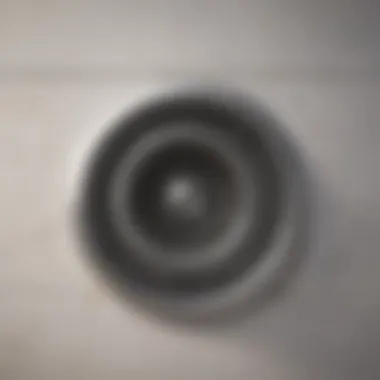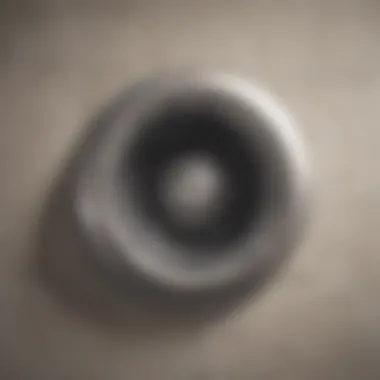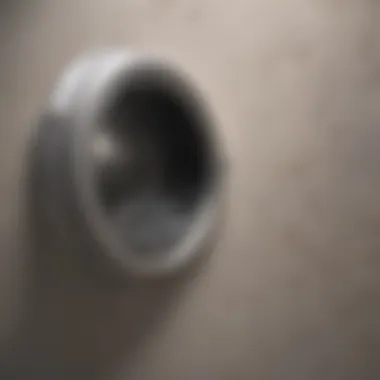Essential Steps for Cleaning Your Stackable Dryer Vent


Intro
Cleaning a stackable dryer vent may not be the most glamorous of home maintenance tasks, yet it holds immense significance. Not only does it keep your appliance running smoothly, but it also reduces the risk of fire hazards. The buildup of lint can be a silent enemy, and neglecting this chore can lead to costly appliances repairs or even worse scenarios. The goal here isn’t just to help your dryer perform at its best; it’s also about ensuring the safety and efficiency of your home.
Most homeowners may not realize the complexity and importance of cleaning the dryer vent effectively. This article will guide you through a step-by-step process to clean your stackable dryer vent, while also discussing tools you might need and signs that point to more significant issues that require professional intervention. Each section of this guide is intended to empower you with knowledge and practical skills. Let's roll up those sleeves and dive deep into maintaining our household heroes—our dryers!
"An ounce of prevention is worth a pound of cure." – Benjamin Franklin
By the end of this guide, you’ll be well-versed in the art of dryer vent maintenance and ready to tackle this crucial task with confidence.
Prologue to Stackable Dryer Vents
Stackable dryer vents may not be the first thing on anyone's mind, but their importance can't be overstated. When it comes to maintaining efficiency in your laundry routine and ensuring safety in your home, understanding the role of these vents is essential. Stackable dryers, designed to save space in cramped apartments or homes, often come with their challenges. A tightly fitted setup could lead to major ventilation issues if not properly cared for.
Understanding Stackable Dryers
Stackable dryers allow homeowners to maximize space. By placing the washer and dryer one on top of the other, you create room for other activities or furniture. However, these compact units rely heavily on an effective ventilation system to work properly. Unlike traditional dryers that have dedicated, spacious venting routes, stackable models often have shorter and more complex paths. Without proper ventilation, issues like reduced dryer performance and increased risk of fire hazards can transpire.
This setup has its quirks; for instance, lint can accumulate rapidly in shorter duct lengths, causing blockages. Regular cleaning becomes not just a maintenance task but a necessary ritual to ensure optimal operation. Knowing that stackable dryers operate on a different logic compared to traditional ones is a key component to maintaining them efficiently.
Importance of Proper Ventilation
You might ask, why is ventilation so vital in stackable dryers? First off, the primary job of a dryer vent is to expel hot air out of the machine during the drying cycle. If this hot air can’t escape, it can create a breeding ground for mold and mildew, not to mention significantly increasing drying time.
Moreover, clogged vents are notorious for becoming fire risks. According to the National Fire Protection Association, failure to clean dryer vents is a leading cause of home dryer fires. Keeping vents clear and in good condition is paramount for personal safety and hygiene. Not addressing these problems can create a snowball effect, leading to early equipment failure or costly repairs.
"Dryer vent maintenance can save you money, time, and – more importantly – lives."
Overall, understanding the infrastructure of your stackable dryer and ensuring that ventilation is up to snuff can lead to better drying efficiency, lower energy bills, and a significantly reduced risk of emergency situations. Maintaining a focus on these aspects will enhance your laundry experience while safeguarding your home.
Tools and Materials Needed for Cleaning
Cleaning your stackable dryer vent isn’t just about aesthetics; it’s about efficient functioning and safety. A clean vent prevents lint build-up, which can lead to overheating, fire hazards, and inefficient drying cycles. Understanding what tools and materials are necessary for this task ensures you're prepared and makes the cleaning process more straightforward and effective.
Essential Cleaning Tools
Having the right tools in your cleaning arsenal can make all the difference. Let’s delve into the must-have items for efficiently tackling your dryer vent:
- Long-handled Brush: A flexible, long-handled brush provides the reach needed to clean deep inside the duct where lint tends to accumulate. You might find ones specifically designed for ducts, sporting sturdy bristles designed for the task at hand.
- Vacuum Cleaner with Attachments: A vacuum with hose attachments is invaluable for sucking up loose lint and debris. If your vacuum has a specialized brush tool, all the better; it can get into those nooks and crannies.
- Screwdriver: Depending on your dryer model, a screwdriver may be needed to remove the vent cover. It’s practical to have a multi-tool or a set of screwdrivers handy, as it can save you from interruptions.
- Flashlight: Sometimes you need a little light to see into the dark recesses of the vent. A good flashlight allows you to spot potential issues and ensures nothing is obstructing air flow.
In addition to these, consider keeping some protective gloves nearby. They can protect your hands from any sharp edges or debris during the cleanup.
Safe Cleaning Solutions
Cleaning solutions add an extra layer of effectiveness to your maintenance routine. However, it’s essential to choose safe and eco-friendly options, especially when you’re tackling indoor appliances like dryers. Here are some cleaning solutions you might consider:


- White Vinegar: A natural cleaner that’s often underappreciated, white vinegar can be used to break down any stubborn lint clumps. Mixing it with water creates a gentle, effective solution for spot cleaning.
- Baking Soda Paste: For tougher buildup, you can mix baking soda with water to create a paste. It’s mildly abrasive and can help dislodge stubborn debris without scratching surfaces.
- Commercial Lint Remover Products: There are specific products designed to dissolve lint and eliminate odors. When choosing these, look for those labeled as safe for use within household environments, ensuring your family’s safety.
- Hot Water Solution: Simply rinsing parts of the dryer vent with hot water can often dislodge stubborn lint. If you use vinegar or baking soda, follow-up with hot water for a nice, thorough cleaning cycle.
Whenever utilizing any cleaning solutions, ensure you’re familiar with their application uses and follow safety instructions provided.
Cleaning your dryer vent isn’t just a chore; it’s a crucial aspect of maintaining a safe home environment. Regularly maintaining your vent can prevent potential hazards down the line.
Equipping yourself with these tools and solutions sets the foundation for successful vent cleaning. With everything organized and ready, you're on the path to a safer, more efficient laundry day.
Step-by-Step Guide to Cleaning the Dryer Vent
Cleaning a stackable dryer vent is not just a mundane chore; it is essential for the optimal function of your dryer and overall safety in your household. Neglecting this task could lead to significant problems, including inefficient drying cycles and, in extreme cases, fire hazards. By following this step-by-step guide, you can ensure that your dryer operates efficiently and reduce the risks associated with clogged vents. Let's break it down into manageable steps so you can tackle this important maintenance task.
Preparing the Dryer for Cleaning
Before diving headfirst into the cleaning process, it is crucial to prepare your dryer and the surrounding area. This preparation establishes a safe workspace and sets the stage for effective cleaning.
Unplugging the Dryer
The process starts with unplugging the dryer. This action is not only a safety precaution, preventing any electrical accidents, but it also sets a focused environment for cleaning. By severing the power supply, you've eliminated the risk of shocks or unintended starts. This step is simple yet vital. If something goes wrong while you're cleaning, at least you wouldn't be dealing with live electrical components. It's a wise and straightforward move, ensuring peace of mind.
Moving the Dryer Away from the Wall
Next up is moving the dryer away from the wall. While you might think it’s a hassle to shift large appliances, this maneuver is necessary for a thorough job. When your dryer is snug against the wall, it restricts access to the vent, which often leads to dust buildup. By creating space, it allows you to reach those tricky spots, making your cleaning efforts more effective. If your dryer has a stacking kit, ensure you handle it carefully to avoid damaging any components. Taking this little extra step significantly enhances your ability to clean those hard-to-reach areas.
Accessing the Vent
Once you've got your dryer safely out of the way, it’s time to access the vent itself. Here’s how to get in there.
Removing the Vent Cover
Removing the vent cover is the next key part of this journey. This step usually involves unscrewing a few bolts, and it’s important to do it right. The vent cover guards the entry point of your duct, and improper handling could lead to damage or misalignment. By taking care with this task, you ensure you can easily replace the cover without any issues later on. When you get the cover off, you'll likely see lint buildup, which is a clear indicator of how necessary this cleaning method is.
Locating the Ventilation Duct
Once the cover is off, the next task is locating the ventilation duct. This duct is the pathway your dryer uses to expel hot air and lint. Understanding its layout is essential for a thorough clean. You’ll often find the duct connected to the back of the dryer and leading outside. Look for bends or kinks, as these areas can accumulate debris more easily than straight runs. Being aware of where this duct leads can also offer insights into your dryer’s ventilation efficiency and potential problems down the road.
Cleaning the Vent Tube
Now onto the main event: cleaning the vent tube. When it comes to cleaning, having the right techniques can make all the difference.
Using a Brush
Using a brush designed specifically for dryer vents is recommended. These brushes are equipped to reach deep into the ducts and dislodge stubborn lint clogs. It's a hands-on approach that often yields rewarding results—seeing all that accumulated lint come out can be quite satisfying. Additionally, ensure that your brush is the right size for your duct to avoid damage or inefficiency. Regular use of a brush helps maintain airflow, enhancing dryer performance and safety.
Vacuuming Debris


After you've brushed the inside, turn to vacuuming debris. This step is crucial as it picks up all the bits that the brush may have loosened but not removed completely. A vacuum cleaner with a long nozzle works best for this part. You want to make sure that all the residual dust and lint are vacated, leaving a clean passage for air. Not only does this improve airflow, but it can also prolong the life of your appliance by reducing strain on its motor.
Inspecting for Damage
Finally, once you’ve cleaned everything out, it’s time to shift gears and inspect for damage. This step often gets overlooked, but it can save you a world of trouble later. Check for any signs of wear and tear—like cracks or holes in the duct—as these can lead to exhaust leaks. Paying close attention to connections can also help you spot if something’s amiss before it turns into a bigger problem. Regular inspections are often ignored, but they can inform you whether it’s time for repair or replacement.
If you follow these detailed steps, cleaning your stackable dryer vent can be a smooth process that keeps your dryer running efficiently and safely. A bit of work now can save you from potential headaches down the line.
Safety Considerations
When we talk about stackable dryer vents, it's easy to overlook the essential safety considerations that can make or break the efficiency and security of your home. Proper maintenance isn’t just a matter of keeping things tidy; it’s fundamentally tied to preventing potential hazards that could arise from neglecting your dryer vent. In this section, we will delve into the serious implications that arise from clogged vents and the health risks linked to poor ventilation. Ignoring these issues can lead to dire consequences, including fires and exposure to harmful indoor air pollutants.
Fire Hazards of Clogged Vents
One of the most pressing dangers associated with clogged dryer vents is the risk of fire. According to the National Fire Protection Association, failure to clean dryer vents is one of the leading causes of home dryer fires. When lint builds up and blocks the airflow, the dryer has to work overtime to do its job. This extra strain can cause the dryer to overheat, increasing the likelihood of a blaze.
Here are a few important points to consider:
- Lint Buildup: A small amount of lint may seem harmless, but it can quickly accumulate, creating a flammable barrier within the vent. Every load of laundry adds to this buildup.
- Heat Generation: The dryer generates heat while functioning, which combined with lint can reach high enough temperatures to ignite.
- Poor Airflow: When air can't flow freely, the appliance overheats even more. It’s a dangerous cycle that can spell disaster.
"Prevention is better than cure; a little maintenance goes a long way in ensuring safety and efficiency."
Taking steps to ensure the vent is clear proves crucial not only for safety but also for maintaining dryer efficiency. An adequately functioning vent can even help your dryer last longer, saving you money in the long run.
Health Risks Associated with Poor Ventilation
The impact of poor ventilation extends beyond just physical safety. It also carries significant health risks that can affect all members of your household. When dryer vents are clogged, it doesn’t just route lint back into your laundry; it can also introduce harmful pollutants into the air you breathe.
Some health concerns tied to poor ventilation include:
- Mold Growth: Prolonged humidity from a malfunctioning dryer can lead to mold, which poses serious respiratory risks. Mold spores can become airborne, making their way into your living space uninvited.
- Indoor Air Quality: Accumulated lint and humidity create a perfect environment for bacteria and allergens to flourish. This can cause or exacerbate conditions such as asthma and allergies.
- Carbon Monoxide Poisoning: If you have a gas dryer, improper venting may lead to carbon monoxide build-up in your home, which is extremely dangerous and can be life-threatening.
Maintaining a clean dryer vent is more than just a chore; it’s integral for protecting your family’s health and well-being. By understanding these risks and taking proactive steps in vent maintenance, you contribute positively to your home environment. Regular cleaning and inspections can be a straightforward but crucial way to enhance both safety and health in your abode.
Common Problems and Troubleshooting
In the realm of stackable dryer vents, being aware of common issues and knowing how to troubleshoot them is crucial for maintaining efficiency and safety in your home. Regularly monitoring the health of your dryer vent can prevent problems before they escalate into significant hazards. Understanding these issues ensures optimal dryer performance, extends the appliance's lifespan, and decreases the risk of fire hazards.
Signs Your Vent Needs Cleaning
Identifying when a dryer vent needs cleaning is essential. Several telltale signs indicate a buildup of lint or other materials that could compromise performance. Here are some indicators to watch for:
- Longer Drying Times: If your clothes are taking longer to dry than usual, that's a solid hint your dryer vent might be blocked. It suggests that the hot air isn't cycling properly, making your dryer work overtime.
- Overheating: If the dryer feels unusually hot when in use, it’s time to check the vent. Overheating can happen if the airflow is obstructed, which could lead to more significant issues down the line.
- Burning Smell: A distinct burning smell emanating from your dryer is never a good sign. It often indicates that lint is accumulating and could pose a fire risk.
- Fluff on Vent Cover: If you see lint or debris around the area where your vent exits the house, it may indicate that the vent has significant lint buildup inside, necessitating immediate attention.
- Increase in Energy Bills: Notice a spike in your energy expenses? An inefficient dryer works harder to do its job, which can translate into higher energy costs.
By keeping an eye out for these signs, you can avoid the headache of replacing your dryer or, worse, facing fire danger.


When to Call a Professional
While many maintenance tasks can be undertaken at home, some situations warrant enlisting professional help. Recognizing when it's best to call in an expert can save you time, stress, and potentially money. Here are scenarios where professional intervention is advised:
- Persistent Clogs: If you’ve attempted to clean your dryer vent's interior and still notice issues with airflow or prolonged drying times, a professional can help locate deeper blockages.
- Age of Venting System: Older dryer vent systems may need more than just cleaning; they might need replacement or significant repairs. If your system is dated, having it inspected by an expert is wise.
- Damaged Ductwork: If while inspecting you notice holes or damage to your ductwork, this becomes a job for the pros. Poorly installed or damaged ducts can create hazards and impair efficiency dramatically.
- Smoke or Fire Risk: Above all, if you ever detect smoke or a burning smell, shut down the appliance immediately and call a professional. This is a serious safety risk that should never be taken lightly.
A professional will have the necessary tools and experience to tackle complex issues safely and effectively, leaving you worry-free. Protecting your home and ensuring your dryer operates efficiently shouldn't be a gamble. Paying attention to signs and knowing when to call in the heavy artillery is essential for long-term maintenance.
Preventive Maintenance Tips
Cleaning and maintaining a stackable dryer vent shouldn't just be a one-off task; it's more like an ongoing dance that requires regular steps to keep everything running smoothly. When we talk about preventive maintenance, we’re emphasizing the importance of being proactive before any significant issues arise. Think of it as giving your dryer a check-up. Just like you wouldn’t ignore the check engine light flashing in your car, ignoring your dryer vent can lead to woes down the line.
Regular maintenance not only enhances the efficiency of your dryer, but it also safeguards your home against potential fires caused by lint buildup. In fact, the National Fire Protection Association has noted that nearly 34% of home clothes dryer fires are caused by lint buildup. By staying ahead of the game, one can avoid unnecessary headaches.
Regular Inspection Schedule
Establishing a consistent inspection schedule means creating a rhythm that works for you. Aim to check your dryer vent at least every six months. However, you may need to increase that frequency depending on usage patterns—if you're a family of four, checking every three months might be wise.
- Assess the venting system regularly: Look for twists, kinks, or lint build-up that could hinder airflow.
- Keep an eye on the dryer itself: Unusual noises or longer drying times can hint at issues.
- Take advantage of lint traps: Always clean them after every use.
By making these inspections part of your routine, you form a habit that not only keeps your appliance in tip-top shape but also fosters peace of mind.
Proper Usage of Dryer Appliances
Using your dryer correctly plays a significant role in how well it performs and how long it lasts. Improper usage can lead to more problems down the road. Here are a few guidelines worth considering:
- Don’t overload the dryer: It may seem tempting to throw in everything at once, but cramming too much in can lead to inefficient drying and potential damage.
- Avoid drying unsuitable materials: Items like rubber-backed rugs or plastic shower curtains can melt or catch fire, contributing to hazards.
- Use appropriate settings: Choose the right drying cycle for the load you have. Knowing the fabric types will extend not only the life of your garments but also keep the dryer vent functioning well.
By following these tips, homeowners can significantly reduce the chances of a clogged vent and minimize the risk of costly repairs. Making these practices a standard part of your laundry routine simply makes sense, ensuring your dryer remains effective and your family stays safe.
"Prevention is better than cure." Regular checks and proper usage can keep minor issues at bay, transforming maintenance from a chore into a means of efficiency and reliability.
Culmination
Cleaning your stackable dryer vent isn't just a chore on a cleaning checklist; it's an essential practice for maintaining both efficiency and safety in your home. As we've discussed throughout the article, neglecting this task can lead to a buildup of lint, which is a major fire hazard. Moreover, poor ventilation causes your dryer to work harder, increasing wear and tear and potentially shortening its lifespan. This could mean shelling out significant cash for repairs or a replacement; not exactly a delightful prospect.
When you take a few hours each year to clean out your dryer vent, you're essentially investing in the longevity of your machine and the safety of your family. The benefits of cleaning go beyond just avoiding disasters; they also include enhanced energy efficiency and optimized drying times. This not only saves you money on utility bills, but it also contributes to a more sustainable household by reducing energy consumption.
Recap of Importance of Cleaning
In summary, the importance of cleaning a stackable dryer vent cannot be overstated. A clean vent ensures proper airflow, which in turn helps your dryer to operate efficiently. A blocked vent may cause your dryer to overheat, leading to potential damage to your appliance and space. Think of it this way: a clean vent is like opening a window in a stuffy room—it just makes everything better. Regular cleaning also identified potential problems, such as damaged ducts or loose connections, before they escalate into larger, more costly issues.
"An ounce of prevention is worth a pound of cure."
Encouragement for Regular Maintenance
Establishing a routine for regular maintenance can be daunting at first, but it can quickly become second nature. Consider scheduling your dryer vent cleaning during seasons when you tend to do a lot of laundry, such as winter and spring. Adding this task to your seasonal cleaning list could ensure it gets done punctually.
Moreover, educate everyone in your household about the signs of a clogged vent: longer drying times, a hotter than usual dryer, or a burnt smell. The more aware people are, the better you can keep tabs on this critical matter. Creating visual reminders or checklists on the fridge can act as excellent prompts to regularly monitor the vent's condition.
By prioritizing this upkeep, you're not merely maintaining a household appliance; you're promoting a more efficient, safe, and environmentally-friendly home. Regular maintenance is the unsung hero of appliance care. Don't wait for problems to knock on your door—stay one step ahead to guarantee your peace of mind.















